You found our list of free escape room puzzle ideas.
Free escape room puzzle ideas are tips and tricks that help you build an escape room from scratch. These suggestions make escape room set-up quick and simple, so you can make escape rooms for kids or adults at home, school, the office, or community centers.
For similar activities, check out our posts on virtual escape rooms and team building puzzles.
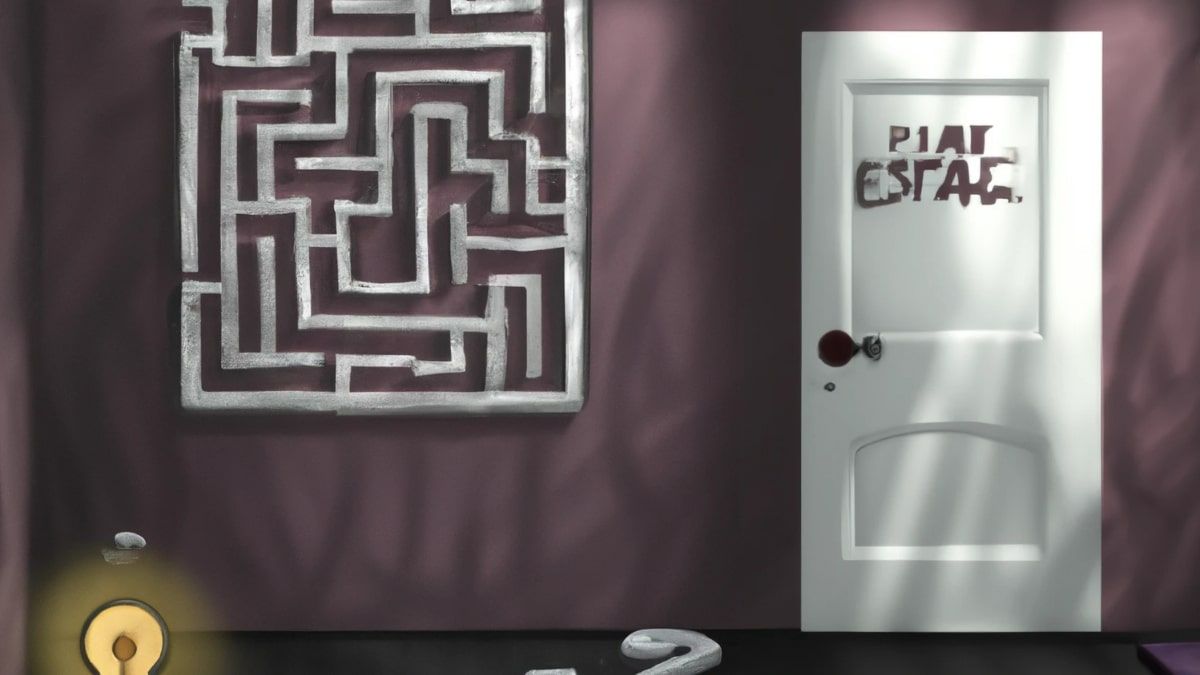
This article contains:
- printable escape room puzzles
- escape room puzzle examples
- free escape room puzzles
- DIY escape room tips
Let’s get to it!
List of free escape room puzzle ideas
From invisible ink to combination locks to crafty hiding spots, here are tricks to create escape room challenges out of normal household objects.
1. Printable Puzzles (Free Templates)
Here are four, ready made escape room puzzles that you can print.
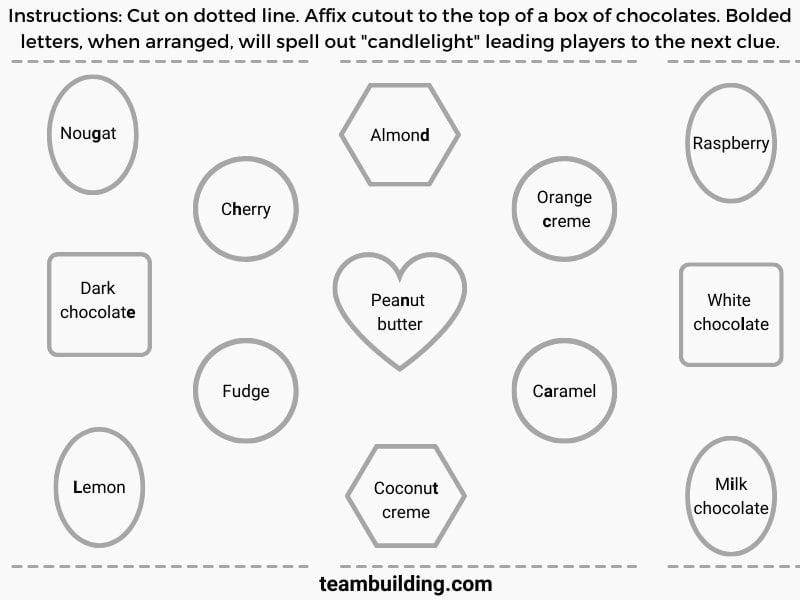
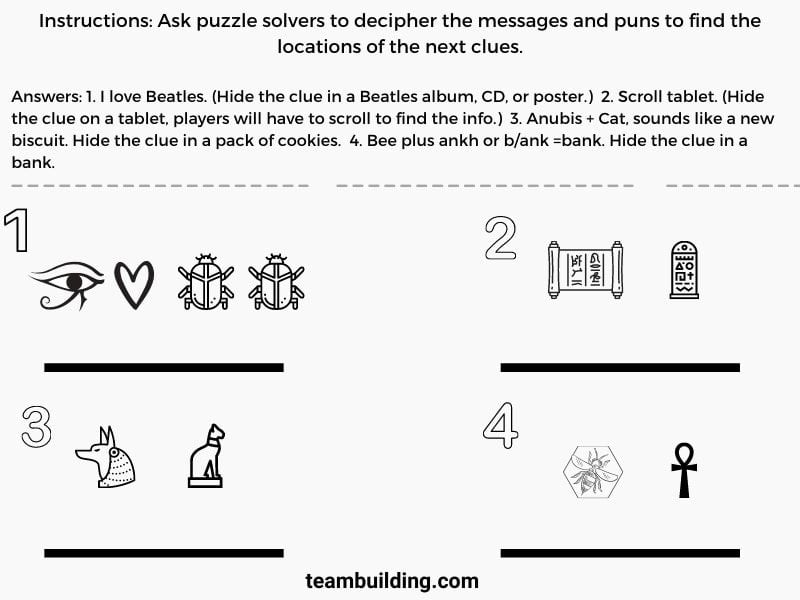
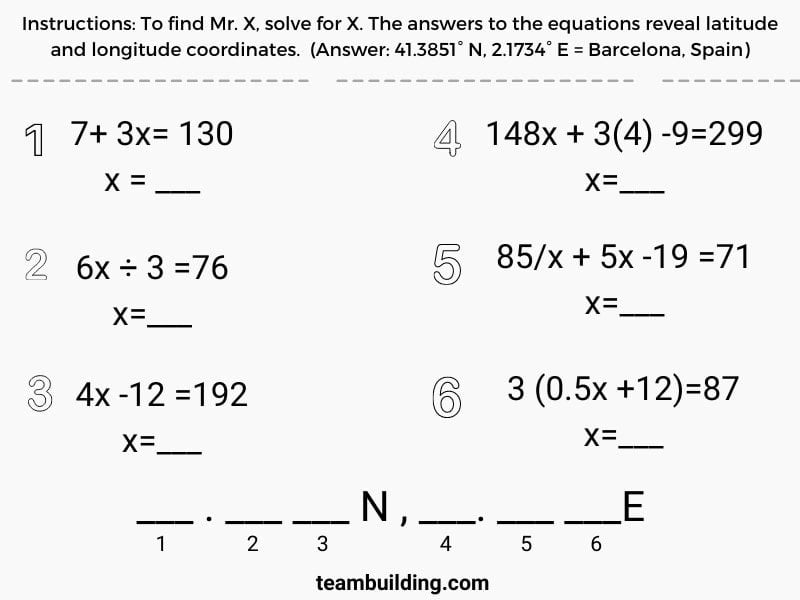
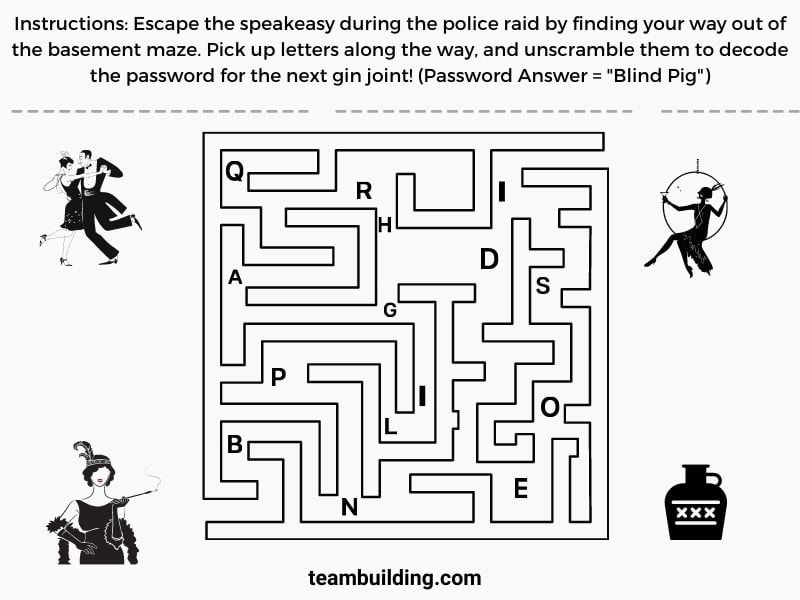
Here is a list of more free printable escape room puzzles from around the web:
- Crime Scene in the Classroom
- Escape The Mummy’s Tomb
- DIY Murder Mystery Escape Game
- Cool Secret Codes for Kids
Feel free to tweak the designs to fit your room’s theme. Online design websites like Canva can help you personalize puzzles to match your game.
2. Compose a message with invisible ink
Writing in invisible ink is a great puzzle for spy-themed escape rooms, and works for any other theme too. The only ingredients you need to mix up a batch of secret spy ink are lemon juice and water.
To make invisible ink:
- Pour lemon juice into a small bowl
- Add a couple drops of water
- Mix the concoction
- Dip a cotton swab into the mixture
- Use the swab to write a message on a piece of paper
- Wait for the paper to dry
To read the letter, hold the paper up to a light. Be sure to include a lamp, candle, or flashlight in the room so that puzzle-solvers can decipher the message. For best results, test read the message beforehand to ensure the letter is legible.
3. Write a secret message on glass
Speaking of secret messages, you can use your finger for writing a note on a mirror, picture frame, or window. The oil from your finger will transfer to the glass, and the message will remain invisible until the puzzle-solvers add moisture. Either supply an electric kettle or garment steamer, write the message in a bathroom with a working shower, or use clues to instruct participants to blow directly on the glass.
4. Place a clue inside a balloon
One of the best places to hide a clue is inside a balloon. Simply slip the object or message into the unblown balloon. Then, fill the balloon with air. Players will need to pop the balloon in order to retrieve the clue, so be sure to supply a sharp object and a hint that players may need to make noise.
This clue is most appropriate for a carnival or prom-themed room, but you could integrate balloons into another setting too. For instance, perhaps a mad scientist uses balloons as part of an experiment to weaponize static electricity, or maybe a kidnapped character received a balloon bouquet gift for a recent achievement.
5. Padlock a pair of scissors
One of the most often suggested free DIY escape room puzzle ideas is to padlock a pair of scissors. Players should need to use the scissors as part of a future clue, and the combination or key to open the padlock should be part of a preceding clue. For example, perhaps players need to cut a string as part of a clue or puzzle, but must first unlock the scissors.
6. Leave a diary lying around
Escape room solvers need to discover directions to crack the case, as puzzle masters may give hints, but not explicit instructions. Of course, providing a straightforward answer key spoils the fun, so add an extra challenges such as:
- A lock with a hidden key
- Too-small print readable only by magnifying glass
- Secret code in need of cracking
- Missing pages
- White crayon on white paper
You can put all kinds of fun and unique content into diaries.
7. Use a broken watch or clock as a combination clue
Most folks have a watch with a dead battery or a broken clock somewhere around the house. If not, then dollar stores usually sell cheap clocks or watches you can use for the task. Simply use the time on the clock as the combination for a lock, then plant the clock in the room alongside a separate clue that says something like, “I need to crack the code, but time has run out…”
8. Bury a clue inside a hollowed-out book
Many people use book safes as a way to store valuables, and you can use a hollowed-out book as a hiding place for a puzzle or clue.
First, buy a book from a library or yard sale, preferably one with a hard cover. Then, hollow out the pages by using a pen-knife to cut a hole, or remove the last pages entirely. You will want to reserve the first few pages, at least, so you can hide the book safe. Glue the safe pages together. Then, place your clue inside the hollow, affix the first pages over the hole using double sided tape, and place the book in a drawer or on a crowded bookshelf.
This Wiki-How article provides a step-by-step guide to making a hollow book.
9. Scrawl a cypher on a popsicle stick
Popsicle sticks are inexpensive, as are edible ink markers. To make a delicious secret clue, scrawl your cypher on a popsicle stick with the food coloring marker, let dry, then hide the writing by making popsicles, chocolate lollipops, or cake pops. Participants will have to eat the snacks to get to the secret message.
10. Hide a clue inside a candle
This clue depends on players figuring out quickly that they need to light a candle, since the wax will need to melt for some time before participants can retrieve the clue.
To make your candle, melt down wax from old candles, or obtain an inexpensive candle-making kit. Pour ¾ of the wax into a jar with a wick and let cool. Then, place the clue, add the rest of the wax, allow the candle to harden, and set in the room.
Or, place the object at the bottom of your jar, and only make a partial candle. Paper may burn, so it is best to opt for physical items like lockets or figurines instead.
11. Use a letter lock
While most locks require keys or number combinations, some locks open with word combinations. We recommend obtaining at least one of these locks for your game, and hiding the letter combination within a word puzzle or book clue.
Here are a few interesting letter lock options:
- Chinese or English letters or numbers
- Combination letter and number lock
- Five letter lock
- Letter padlock
If you cannot acquire a letter lock in time for your game, then use a number lock and devise a secret code where letters translate to numbers.
12. Place a clue inside a locket
Lockets are great hiding places for clues, because they contain compartments to place pictures or words. You could even hide a message or image behind a photograph. If you do not already own a locket, purchase an inexpensive pendant from Etsy. To signal to players that the piece of jewelry is a clue, match the locket’s design to a piece of artwork in the room. Or, place the locket inside a locked jewelry box amidst other costume necklaces and rings.
13. Submerge a clue inside a vase
Vases are great hiding spots for hints, because you can cover the clues with water, sand, marbles, or a mix of materials.
First, hide your clue inside a vessel such as a small tupperware container to protect it from damage. Then, place the object at the bottom of a vase, and add the filler. Top the container with flowers or feathers. Be sure to have a bucket handy so that players can empty the contents without making too much of a mess.
14. Add an interloper to a photo
This puzzle is ideal for art and history buffs, or eagle-eyed and observant players. First, select a famous painting or photograph, or a personal family photograph, and print a copy. Then, select another element to add to the picture, such as an extra person. On the back of that cut-out, write a clue. Then, tape the addition onto your original image, place the photo in a frame, and hang the picture somewhere in the room.
15. Create a maze
Mazes make great escape room puzzles and games. To create your own maze, use an online generator, or download a printable maze. Most coloring books include a maze or two, so check out the book store aisle of your local dollar store for more options. To make mazes more interactive, include letters on the correct path that players must unscramble to find the next clue.
16. Use your phone as a lock
Most folks have a padlock hanging out in a junk drawer, gym bag, or closet, and nearly everyone has a lock on their phone. Simply reprogram the unlock code on your smartphone, and hide the combination within an escape room clue. Consider setting your wallpaper as a picture or email, so that users see the clue immediately. After all, you do not want players to snoop around in your personal information!
17. Write instructions in a foreign language
First, double check that none of your players is fluent in the chosen language. Be sure to confiscate phones and smart devices so that participants cannot use translate features to quickly decipher the message. Instead, players use a bilingual dictionary to interpret instructions. Translation takes time, so keep the message short. To further help players find the right words, provide clues such as earmarking dictionary pages, highlighting the words, or writing down the necessary page numbers as part of another clue.
18. Mix a cut-up letter into a pile of shredded paper
By using a shredder or pair of scissors, turn a letter into a jigsaw puzzle. First, gather shredded paper. If you own a home-office shredder, then empty the contents of the bin. If not, then you can cut up paper by hand. Note that when using scissors, you do not need to cut paper as finely as a machine would. Next, write your letter, and then cut it into pieces. Be sure to distinguish the letter so it is easier to find, such as by using a slightly different color paper or cutting the edges with decorative craft scissors. Do not forget to supply players with tape, so that they can piece the letter together!
19. Place an object in the hidden pocket of a coat
Many coats have a secret pocket within the inner lining. If you own a jacket with a secret compartment, then use the hidden pouch as a place to stash a clue. First, place the object in the secret pocket, then hang the jacket on a coat rack, the back of a chair, or lay the coat on a surface. Then, leave a clue alerting players to the fact that they have to check inside the coat, such as a message that says, “It’s getting colder outside, but you’re getting warmer in your hunt for answers. Find the next clue in a pocket thieves cannot reach.”
20. Hide a prize inside a cereal box
Cereal boxes make fun and playful escape room hiding places. First, get a cereal box. Then, hide an object or envelope inside the bag. To avoid wasting food, fill the bag with only a little bit of cereal, or use packing peanuts instead. Lead players towards the clue with a message like, “breakfast is the most important meal of the day… be sure to finish it” and place the next puzzle on the back of the box.
21. Craft a cryptex
A cryptex is a puzzle that is similar to a combination lock. To crack a cryptex, spin the dials until you land on the correct combination. By using Styrofoam cups, you can create your very own cryptex. Simply stack cups together, write a message down the side, then disassemble and poke holes in the cups corresponding to their order so that players can deduce how to arrange the cups to crack the code.
Escape room puzzle examples
Here are examples of the most common escape room puzzle types.
22. Find the key or combination
Opening a lock is one of the most popular escape room challenges. In fact, some escape rooms contain several locked boxes or doors in need of opening. In the case of combination locks, players must find numbers or letters that release the latch. Padlocks or door locks often require keys that organizers hide around the room. Occasionally, game masters provide decoy keys and players must deduce which key is correct. Or, participants might need to find a passcode to enter into a digital lock, such as a computerized safe or phone screen.
23. Math puzzles
Players often need to use numbers to crack locks, and game masters up the challenge by deriving those numbers from math puzzles. Participants may discover an equation to solve, geometric shapes to assemble, patterns to predict, or Sudoku boxes to fill. The solutions to these puzzles lead to the next clue. Game masters may pose math puzzles on worksheets or whiteboards within the room, and may require players to hunt for numbers. For instance, players might spot five red birds and six blue birds hidden in pictures around the room, and figure out that one number of the combination is thirty by multiplying the birds together.
24. Word puzzles
Number whizzes are not the only puzzle solvers; word nerds get a chance to shine during escape games too. Escape rooms often contain word puzzles and translations that require players to interpret blocks of text, translate passages from real or imaginary languages, or spot errors or hints that lead to clues. Escape rooms puzzles may include word scrambles, word searches, riddles, crosswords, anagrams, or other language-based hints.
25. Secret messages
Secret messages are similar to word puzzles, only instead of secret code, the writing is invisible. Players might need to use a blacklight, a candle, or steam to reveal phrases. Or, the message may be nonverbal. For instance, objects in photographs might spell out words, and paintings may act as hieroglyphics.
26. Morse code
Morse code transmitted important information throughout history, so it makes sense that gamemasters use the secret code as an escape room clue. The language consists of signals known as dots and dashes. Players might stumble across a written transmission, or may hear an audio recording and need to decipher the hidden message.
27. Escape room games
DIY escape rooms often use games and physical challenges as well as self-guided puzzles. Players may complete an obstacle course, build a spaghetti tower, unfurl a human knot, answer trivia, or race through minute-to-win-it games to unlock the next clues. Unlike self-guided puzzles, these games require a facilitator who oversees the challenge and gives the next clue once players win.
For inspiration on games to include in escape room challenges, check out our post on team building games.
28. Jigsaw puzzles
Sometimes, the puzzles players need to solve are literal puzzles. Gamemasters might hide a hint within a puzzle game. For instance, participants assemble a jigsaw puzzle, and the finished picture points to the next clue. Or, players might have to find and arrange the pieces of a torn-up letter. Escape room creators can use 3-D puzzles like cryptexes, puzzle boxes, and wooden or metal puzzles, too.
29. Scavenger hunt
Escape room players often hunt for objects such as keys, passwords, physical clues, or pictures. Feel free to draw inspiration from Disneyland’s hidden Mickeys and hide images around the room for players to find. Also, consider using secret compartments or hollow decoy objects as clever hiding spots for clues.
30. Mazes
Escape rooms often use mazes as puzzles. Players may trace a path through a paper maze, perhaps collecting letters that spell out a hint along the way. Or, participants may help a ball through a wooden maze to unlock a secret compartment. If you have enough space in your home or playing area, you may even create a lifesize maze that players must navigate to get to an adjoining room or to find another clue!
DIY escape room tips
Here are a few key pointers for building a successful escape room at home or the office.
31. Test every puzzle and clue before starting the game
Escape room puzzles often build off of each other, and if one clue fails to function, the whole puzzle may be unsolvable. To avoid disappointing situations, test every clue before inviting participants to enter the room.
32. Devise a Plan B or two
Despite your best efforts and careful preparation, plans may still go awry. Preparing backup plans in case of mechanical failure or participant confusion can help keep the game on track. This approach may include printing off two copies of puzzles, preparing spare props, or recruiting a hint-giver with good improvisation skills.
33. Pick a fun escape room theme
Part of the fun of escape rooms is the ability to step into the shoes of a character and play make believe. Choosing a theme can set a fun atmosphere for your room and help players get into the spirit of the game.
Here is a list of some fun escape room themes:
- secret agents
- the roaring 20’s
- ancient Egypt
- witches and wizards
- alien spaceship
- mad scientist’s laboratory
- wedding day
- zombie apocalypse
- haunted house
- arctic expedition
- Greek or Roman mythology
- ghost ship
- prison break
- jungle or safari
- rainforest
- prom gone wrong
Feel free to draw inspiration from movies, books, TV shows, and famous figures when selecting a theme, too.
34. Vary the clue types to suit different skill sets
Escape rooms are a team activity, and each member of a team will have different skills and strengths. To engage all participants equally, vary your clue types to accommodate different strengths and learning styles. For instance, incorporate allusions to pop culture, literature, and science, use both math and word puzzles, and plan some games which require physical coordination and others that are trivia or knowledge based.
Printable escape room puzzles
While designing your own escape room from scratch is not as daunting a task as it might first appear, you may be short on time, or you may want to rely on existing resources for your first few runs. To make the process easier, we compiled a list of printable escape room puzzles and games from around the web, all either free or low-cost options.
35. Lock Paper Scissors
Lock Paper Scissors provides downloadable escape room kits in various themes for the price of $29 each. The site also hosts a trove of valuable resources and advice for creating your own DIY escape rooms.
Visit Lock Paper Scissors
36. Mystery Locks
Mystery Locks is an Etsy seller that specializes in printable escape room games. Examples of themes include Escape the Haunted Catacombs, Jackpot in Las Vegas, The Kraken Attack, plus dozens of others!
Visit Mystery Locks
37. Printable Secret Decoder Wheel
This printable secret decoder wheel is a free downloadable escape room puzzle players can use to crack secret codes.
Download Printable Secret Decoder Wheel
38. I Spy Game Printables
Perfect for younger puzzle solvers, these free I Spy Game Printables come in over 40 themes like outer space, mermaids, fairy tales, and superheroes.
Download I Spy Game Printables
39. Printable Escapes
Website Printable Escapes presents Amazing Adventure Society – The Nordic Necklace, a free printable escape room experience. The game includes a story, puzzles, hints, and answers.
Visit Printable Escapes
40. Escape Team
Escape Team is a printable, interactive pen-and-paper escape game that incorporates smartphones into gameplay. Players can access the training mission and first mission for free, then purchase additional missions for a small fee.
Visit Escape Team
41. Word Puzzle Escape Room Activity
These word-based escape room puzzles include riddle-puzzles, pictograms, cryptograms, and logic puzzles. The kit includes answer keys. Both a paper-only version and digital hybrid version are available.
Access Word Puzzle Escape Room Activity
42. Jumanji Escape Room
This Jumani-themed downloadable escape room includes a game board, pieces, and jungle-themed critical thinking challenges.
Access Jumanji Escape Room
43. All Summer in a Day Escape Room
An educator designed this escape room, based on Ray Bradbury’s “All Summer in a Day,” as a literary-themed activity for adults and young adults. The editable PowerPoint download includes riddles, instructions, and answers.
Access All Summer in a Day Escape Room.
44. The Sleeping Curse
The Sleeping Curse is a Harry Potter-themed escape room adventure complete with print and cut puzzles, posters and invitations, and an accompanying YouTube playlist to help set the mood.
Download The Sleeping Curse.
If you want to design your own puzzles, then here are some helpful tools and guides:
- Maze Generator
- Math Puzzle Game Generator
- Word Search Puzzle Generator
- Secret Code Puzzle Maker
- Breakout EDU
- Escape Room Design Blueprint
- How to Make Your Own Scratch Off Cards Tutorial
You can find more online too!
Final Thoughts
By using the tips, tricks, and tools included in this post, you will be a master puzzle master in no time. Though escape rooms take brainpower to solve, setting up a challenging game does not require as much manpower as you might suspect. Using pre-made resources helps you set up the room in a snap, so you can focus on helping players have fun.
Next, check out our tips for escape rooms and this post on interactive murder mystery games.
